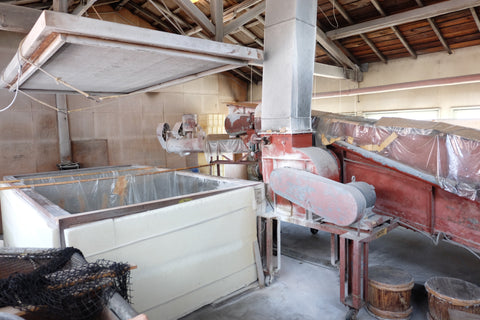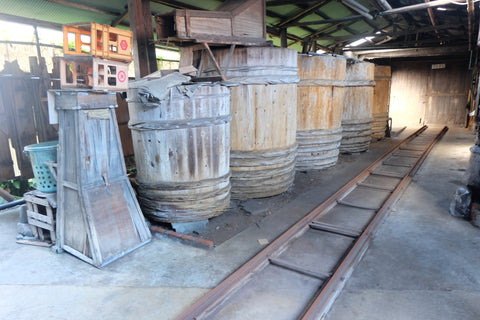Making miso at a miso brewery ~Welcome to the miso brewery tour~

Hello, this is Yukimi from MISOVATION staff.
The miso soup that MISOVATION delivers every month uses miso made with great care in miso breweries all over Japan.
The number of miso breweries is decreasing year by year. And while the number of breweries that are open to the public is limited due to reasons such as hygiene, I would like everyone to know how miso is made at the miso brewery! With that in mind, I gave a special tour of the miso storehouse to Kato Heitarō Shoten, which manufactures this month's miso, Iichi Miso Kanagawa Blend.
This time, we will deliver it as a "Miso Brewery Tour" so that everyone can have a simulated experience of visiting a miso brewery!
|
table of contents Starting with making rice koji |
The three essential ingredients for making miso (rice miso) are “rice koji,” “soybeans,” and “salt.” It takes four days to prepare miso for making miso called “shikomi”. This time, under the guidance of Mr. Atsushi Kato, the 7th generation representative, we will introduce each process from rice koji and soybean preparation, miso preparation, fermentation and aging, to shipping.
Starting with making rice koji
Put on a sanitary cap and start the tour!
When you pass through the door of the historical wooden factory, you will be enveloped in the sweltering heat and fragrant aroma of miso. In the factory, there are gaps for the heat and steam from the machines to escape, so the air conditioning is almost ineffective.
The first thing I was shown was a facility where wooden barrels were lined up on two floors. Here, the rice is washed, soaked in water, drained, and steamed.

The rice is washed and soaked in water in a tub on the upper floor, and then steamed in a tub on the lower floor. The work of stirring the steamed rice to remove the rough heat is done manually.

The steamed rice in the vat on the lower floor is further cooled down through a device like a belt conveyor. As the koji mold is sensitive to heat, the koji mold will die if the rice is not cooled down before adding the koji mold.

Aspergillus oryzae is contained at the end of the belt conveyor, and the well-chilled rice is mixed with the aspergillus oryzae here and put into a large square container made of stainless steel. This container is called a floor, and it is left overnight here for fermentation. Since rice koji generates heat during the fermentation stage, it is adjusted to keep the temperature around human skin so that the koji mold will not die due to its own heat.

On the second day of fermentation, koji mold is grown in a koji-making machine called Tomzet. In this facility, the temperature is controlled so that the koji mold does not die, and the humid air creates an environment that the koji mold prefers, promoting the growth of the koji mold. In addition, as the koji mold grows, it turns into spores, and it seems that this also has the function of loosening the rice to prevent it from sticking together. I will sleep here again for the night.

Making rice koji up to this point takes a total of three days and most of the preparation period.
We are also particular about the preparation of soybeans
Next, we were shown a huge pressure cooker for steaming soybeans. Surprisingly, this is the oldest pressure cooker in Kanagawa Prefecture! Normally, it takes about 4-5 hours to steam soybeans, but it seems that steaming in a pressure cooker takes about 1 hour.
Soybeans start preparing on the third day of rice koji making. Wash → Soak in water → Drain → Steam → Cool.

By the way, it seems that the soybeans used to make miso are either steamed or boiled, depending on how each company thinks. Why does Kato Heitaro Shoten choose to steam? When asked why...
If you boil it for a long time, the umami of the soybeans will appear in the broth. However, by boiling, the soybeans themselves become white and beautiful, and the finished miso becomes a beautiful color without dullness.
On the other hand, when steamed, the soybeans retain their color, so the miso tends to darken. However, in the case of Kato Heitaro Shoten, they want to prioritize the umami of the soybeans over the appearance of the color, so they choose the method of steaming and applying pressure to retain the umami of the soybeans. is.
The miso "Iichi Miso Kanagawa Blend" used in this month's MISOVATION uses a rare soybean called "Tsukui native soybean", which is said to be a phantom soybean. So you make miso in a way that brings out the best in you.
From miso preparation to shipment
Now, the rice koji and soybeans, which are the ingredients of miso, are ready. From here, it is finally time to prepare miso with salt.
Salt and rice koji are mixed together in a place called a shikomi-ba to make "shiogiri koji". Finely mashed soybeans are added to it, and if necessary, water is added to adjust the softness while mixing.
Once thoroughly mixed, the mixture is placed in a large wooden pail, stepped on, and topped with a weight. The preparation of miso is now complete!

Depending on the type of miso prepared, it is transported to a warm brewing room where the temperature can be controlled, or to a storage room for those that are better aged in a natural environment, where it enters the fermentation and aging process.
By the way, this wooden bucket has a capacity of 2 tons and is nearly 2 meters tall.
How did you do something so heavy...? ?
The answer lies in the rails laid out throughout the factory. I was also a little curious that there is something like a train track, but it runs on these rails like a train and carries wooden barrels. It seems that the miso storehouse that uses railroad tracks is quite rare.

The prepared miso is carefully aged for several months. By the way, the longer the miso is aged, the darker the color. Different types of miso, such as white miso and red miso, are produced according to this aging period.
This brewery uses 28 wooden barrels, and the temperature of each wooden barrel is measured and controlled while aging.
After the maturation period is over, the next step is preparation for shipping. The miso is taken out of the storehouse and manually dug out.

The unearthed miso goes through a process called miso straining, and is finally shipped after being filled, packaged, and inspected at the packing station. This miso stuffing process requires delicacy and physical strength, but it is done by hand one by one.

It is said that the wooden barrels that have been emptied by digging out the miso are not washed until the next season. By leaving the wooden barrel with miso on it, it seems to be effective in preventing the growth of mold and bacteria in the wooden barrel. By carefully managing the wooden barrels in this way, the wooden barrels currently in the warehouse have been in use for about 90 years.
Lastly, we asked Mr. Atsushi Kato, the 7th generation representative, why they make miso in wooden barrels, which are time-consuming, while many miso breweries use tubs that are easy to maintain, such as those made of stainless steel.
According to him, there are two major advantages of using wooden barrels. The first is that the miso has good air permeability, making it easy for the miso to breathe, which promotes fermentation. It seems that it is the point that it is finished in delicious miso because it is hard to get sudden temperature changes.
However, apart from these merits, he feels that the world has come to see value in the fact that he has continued to make miso using traditional methods. is.
While cherishing the value of miso itself, which we have been doing for a long time, we would like more people to know the goodness of miso while taking on various new initiatives. Such feelings were felt from the end of the story.
How was the miso brewery tour so far?
I would be very happy if you could feel a little more familiar with the miso made in the miso storehouse!
It seems that some of the miso breweries around the country hold factory tours for the general public, so be sure to look for them in your neighborhood or at the places you visit on your trip.
Thank you very much to Kato Heitaro Shoten for their cooperation.
See you next time♪

